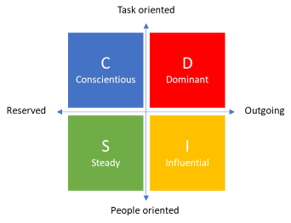If you are new to the idea of Team Praxis, please read our introduction to the concept before using the table below to improve your communications with team members, stakeholders and anyone else involved in your project, programme or portfolio.
 The goals of change management are to:
The goals of change management are to:
- define the organisational change required to convert outputs into benefits;
- ensure the organisation is prepared to implement change;
- implement the change and embed it into organisational practice.
When implementing these goals people with different character traits would perceive change management plans and techniques in different ways.
 Concientious behaviour would typically propose or want to see: Concientious behaviour would typically propose or want to see:
-
a formal, systematic and evidence-based approach to defining comprehensively what needs to change to deliver the formally agreed and measurable benefits; -
a thorough assessment of the readiness of the organisation to accept the change using a tested and objective model; -
A plan to implement the change which is detailed, realistic and with minimal risk to achievement; -
A formal approach to how the change is made with rigorous assessment of progress against agreed performance metrics. Someone exhibiting concientious behaviour would typically be perceived as: -
more focused on the processes, technology and information perspectives rather than the organisational and people aspects of the change; -
requiring a formalised, comprehensive and rigorous approach to making change; -
seeking perfection at all stages of the change and to take an iterative approach to reduce uncertainty. |  Dominant behaviour would typically propose or want to see: Dominant behaviour would typically propose or want to see:
-
the change defined objectively, simply and with agreed milestones for implementation and achievement of benefits; -
a high level review of the readiness of the organisation with a focus on identifying and dealing with obstacles to implementation; -
a sufficiently detailed and challenging plan which is committed to by all key stakeholders; - regular progress monitoring and flexibility in the way that the change is implemented to allow the leader maximum freedom to ensure targets are met.
Someone exhibiting dominant behaviour would typically be perceived as: -
less focused on the resistance to or challenges of making the change for individuals but rather on the delivery against the plan and the meeting of targets; -
wishing to minimise the effort on the planning of the change and maximise it on implementation and to be in control of the process; -
a decisive decision maker who will be happy accept uncertainty and work through challenges in implementing the change in a pragmatic manner. |
 Steady behaviour would typically propose or want to see: Steady behaviour would typically propose or want to see:
-
an approach agreed with all key parties that will define the change together with the impact on people during and after implementation; -
engagement with people impacted by the change on a personal basis to collectively assess their readiness for the change; -
a realistic plan that builds in time for individuals to be supported during the change; - an inclusive and open approach as to how the change is made that takes account of individual needs and expectations through the process.
Someone exhibiting steady behaviour would typically be perceived as: -
being sympathetic to any resistance to change and the need for open discussions with people regarding the feelings of those impacted; -
competent and patient who is considerate of the effort needed to deliver change; -
co-operative, easy to approach and supportive around the process of implementation and happy to input to help others. |  Influential behaviour would typically propose or want to see: Influential behaviour would typically propose or want to see:
-
the change defined through early interaction with the team and stakeholders including unintended benefits; -
a broad consideration of the readiness for change of the organisation involving those that will be ultimately impacted; - a plan which has involved engagement with people impacted by the change most likely through group interactions or discussions
- an informal approach to the way in which the change is made allowing flexibility to react including changing the targets to suit the situation.
Someone exhibiting influential behaviour would typically be perceived as: -
being sympathetic to any resistance to change and wishing to engage with people to identify options to effective implementation; -
informal and collaborative and willing to be actively involved with others during the planning process; -
An ideas generator who would look for alternatives before and during the implementation of the change. |
Thanks to Donnie MacNicol of Team Animation for providing this page.
 The goals of change management are to:
The goals of change management are to:
 Concientious behaviour would typically propose or want to see:
Concientious behaviour would typically propose or want to see: Dominant behaviour would typically propose or want to see:
Dominant behaviour would typically propose or want to see: Steady behaviour would typically propose or want to see:
Steady behaviour would typically propose or want to see: Influential behaviour would typically propose or want to see:
Influential behaviour would typically propose or want to see:



